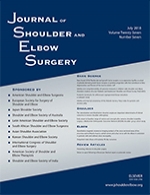Recent Research
Good functional outcomes expected after shoulder arthroplasty irrespective of body mass index
Good functional outcomes expected after shoulder arthroplasty irrespective of body mass index
Posterior Cruciate Ligament: Anatomy and Biomechanics
Posterior Cruciate Ligament: Anatomy and Biomechanics
The Utility of Biologics, Osteotomy, and Cartilage Restoration in the Knee
The Utility of Biologics, Osteotomy, and Cartilage Restoration in the Knee.
Do Outcomes of Osteochondral Allograft Transplantation Differ Based on Age and Sex? A Comparative Matched Group Analysis
A review of prospectively collected data of consecutive patients who underwent OCA by a single surgeon with a minimum follow-up of 2 years was conducted. The reoperation rate, failure rate, and patient-reported outcome scores were reviewed.
Outcomes of Latarjet Versus Distal Tibia Allograft for Anterior Shoulder Instability Repair: A Matched Cohort Analysis
Anterior glenoid reconstruction with fresh distal tibia allograft (DTA) has been described for management of recurrent shoulder instability, with encouraging early outcomes; however, no comparative data with the Latarjet procedure are available.
The Utility of Biologics, Osteotomy, and Cartilage Restoration in the Knee
The management of complex cartilage and meniscal pathology in young, athletic patients is extremely challenging. Joint preservation surgery is most difficult in patients with concomitant knee pathologies, including cartilage defects, meniscal deficiency, malalignment, and/or ligamentous insufficiency. Clinical decision making for these patients is further complicated by articular cartilage lesions, which often are incidental findings; therefore, treatment decisions must be based on the confirmed contribution of articular cartilage lesions to symptomatology.

















